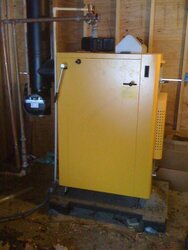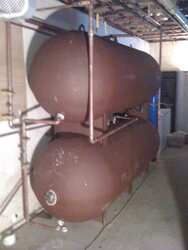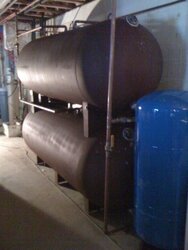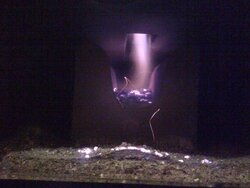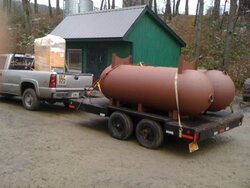I have my Paxo 40 with 1000 gallons storage up and running. The boiler is in an outbuilding 75 feet from the house with 1000 gallons (2x500 propane) in the basement. With a lot of help from Mark at AHONA, and Nofossil's notes, I got the system installed and running in about 6 weeks - picked up unit 11/6 and first fire 12/16 (delays getting 1 1/4 copper fittings at a reasonable price). Underground piping is 1 1/4 PEX and the rest is mostly copper. I do not have my heat exchanger in yet to connect the tanks to the radiant in floor, so I basically have a VERY BIG radiator in a 2500 sf basement. I use a standard box fan to move the air around. This actually works to reduce the load on the existing propane system and makes for a nice warm basement. Basement is about 72 degrees right now, the slab near the storage tanks is up to 80F. One week in to firing, I am still learning how to reliably fire the boiler. I resplit some of my wood today and it seems to burn a little better.
Orlan Paxo 40
- Thread starter Hunderliggur
- Start date
-
Active since 1995, Hearth.com is THE place on the internet for free information and advice about wood stoves, pellet stoves and other energy saving equipment.
We strive to provide opinions, articles, discussions and history related to Hearth Products and in a more general sense, energy issues.
We promote the EFFICIENT, RESPONSIBLE, CLEAN and SAFE use of all fuels, whether renewable or fossil.
You are using an out of date browser. It may not display this or other websites correctly.
You should upgrade or use an alternative browser.
You should upgrade or use an alternative browser.
- Status
- Not open for further replies.
huffdawg
Minister of Fire
Hi Hunderligger,Nice Job. Could you explain how you plumbed boiler to the storage tanks ,what size is your pressure tank ,and what was your method for laying the 1-1/4 pex in the groud.
Merry Christmas Huffdawg
Merry Christmas Huffdawg
Boiler circulator is at the boiler and the boiler is protected from low temp with a 140F Danfoss mixing valve and a hot supply bypass back to the boiler. Dual insulated 1 1/4 PEX is run though 6 inch waste pipe from the out building to the house. MAKE THIS RUN AS STRAIGHT AS POSSIBLE! It is a little difficult to snake dual insulated 1 1/4 PEX though 75 feet of 6 inch pipe with two 45 degree bends (I know Mark at AHONE - you said 22.5 degree fittings but they are not available locally). 6 inch pipe was trenched in with a tracked walk behind 48 inch ditch digger. While you are at it you can put your cold water line out to the boiler shed and AC power, and Ethernet (why not) cable in the trench while you have it open. The tanks are plumbed in parallel with ball valves on each tank to balance the flow (supply and return). There are separate parallel connections for the heat exchanger with ball valves. All total there are 9 ball valves in the piping (one for Danfoss hot in, two on boiler hot in to tank, two on tank cold out to boiler, two on hot exchanger supply and two on cold exchanger return). Automatic cold water make-up is at the boiler. Boiler also has Pressure/Temperature relief valve and air-scoop air eliminator. Pressure tank is 86 gallons and is plumbed in between the boiler output and the ball valves for the input to the storage.
Watching it rain now and melt the two feet of snow we got last weekend. Hopefully my basement walkout drain will handle the flow.
Merry Christmas
Watching it rain now and melt the two feet of snow we got last weekend. Hopefully my basement walkout drain will handle the flow.
Merry Christmas
huffdawg
Minister of Fire
Hunderliggur said:Boiler circulator is at the boiler and the boiler is protected from low temp with a 140F Danfoss mixing valve and a hot supply bypass back to the boiler. Dual insulated 1 1/4 PEX is run though 6 inch waste pipe from the out building to the house. MAKE THIS RUN AS STRAIGHT AS POSSIBLE! It is a little difficult to snake dual insulated 1 1/4 PEX though 75 feet of 6 inch pipe with two 45 degree bends (I know Mark at AHONE - you said 22.5 degree fittings but they are not available locally). 6 inch pipe was trenched in with a tracked walk behind 48 inch ditch digger. While you are at it you can put your cold water line out to the boiler shed and AC power, and Ethernet (why not) cable in the trench while you have it open. The tanks are plumbed in parallel with ball valves on each tank to balance the flow (supply and return). There are separate parallel connections for the heat exchanger with ball valves. All total there are 9 ball valves in the piping (one for Danfoss hot in, two on boiler hot in to tank, two on tank cold out to boiler, two on hot exchanger supply and two on cold exchanger return). Automatic cold water make-up is at the boiler. Boiler also has Pressure/Temperature relief valve and air-scoop air eliminator. Pressure tank is 86 gallons and is plumbed in between the boiler output and the ball valves for the input to the storage.
Watching it rain now and melt the two feet of snow we got last weekend. Hopefully my basement walkout drain will handle the flow.
Merry Christmas
How far does the heated water from the boiler go into the top of the storage tank ? I would guess this would be the same distance for hot water discharge from the tanks.
Also can you bypass your storage and run directly off your boiler to heat your house.
I guess you must be able to,since its plumbed in parallel.
At least you had a white christmas.
Cheers
The hot water from the boiler discharges into the very top of the tank (no dip tube). The cold(er) water return to the boiler comes from a port welded into the bottom end of the tank (by Mark and Nate at AHONA - I don't do welding). See Tank Rear picture. No, I cannot bypass the tank and run directly. The heat exchanger loop draws from a separate hot at the top of the tank and returns to a seperate low return (see tank from picture). The top of the tanks heat quickly so that is not a robably. There is stratification in the tanks (20 to 40 degrees), but my radiant floor system only wants 130-135 input anyway. The tanks are plumbed in parallel and will stratify if te boiler is not running.
Just restarted and reloaded the fire. I'll get the timing down eventually ;-)
Yes, we had a very white Christmas. Now it is a sloppy mess with the snow melting while it is raining. My drain is still working fine. Put the goose in a shelter since a fox got two chickens last night. We'll see if the live trap and a chicken wing (fom last ninght) temp the predator.
Just restarted and reloaded the fire. I'll get the timing down eventually ;-)
Yes, we had a very white Christmas. Now it is a sloppy mess with the snow melting while it is raining. My drain is still working fine. Put the goose in a shelter since a fox got two chickens last night. We'll see if the live trap and a chicken wing (fom last ninght) temp the predator.
stee6043
Minister of Fire
Couple questions: Why did you choose to plumb your tanks in parallel? Are you measuring temps top, mid and bottom on both tanks to see if they are charging at close to the same rate? Do you have valves that will let you modify flow if one tank is getting the bulk of the flow? I think you might be the first to try to plumb two 500 gallon tanks in parallel. Could be interesting!
Are you planning on insulating those tanks? You might be surprised at how many btu's you'll loose right out the wall next to those tanks. I'd get 'em wrapped up asap and save some wood!
Are you planning on insulating those tanks? You might be surprised at how many btu's you'll loose right out the wall next to those tanks. I'd get 'em wrapped up asap and save some wood!
leaddog
Minister of Fire
stee6043 said:I think you might be the first to try to plumb two 500 gallon tanks in parallel. Could be interesting!
He's not the first. I have mine plumbed both parallel and series. I have 4tanks and I have them plumbed with two tanks in series and then the sets are in parallel. That way I get better stratification.. I made sure I had equal lenght lines to my manafolds so they would charge and discharge equal. seems to work well. Mine are set vertical though. I think if I had 2 tanks horizonal stacked I would plumb them in series.
Yes when you get them insulated you will find it alot easier to get them up to temp. They are a VERY BIG radiator.
leaddog
WoodEnergy
New Member
Hunderliggur- nice job! looks like another quality gasser install.
I'm curious- Have you folks done any testing on how well your tanks stratify? I am planning to run 4 horizontal tanks (2000 gal. total) all parallel so flow to each tank is lower to allow better stratification. If I'm getting 10 gallons per minute to storage, 4 tanks get 2.5 gpm each. I want my deltaT as high as possible. It seems like series would cause more turbulence in the tanks.
I'm curious- Have you folks done any testing on how well your tanks stratify? I am planning to run 4 horizontal tanks (2000 gal. total) all parallel so flow to each tank is lower to allow better stratification. If I'm getting 10 gallons per minute to storage, 4 tanks get 2.5 gpm each. I want my deltaT as high as possible. It seems like series would cause more turbulence in the tanks.
I'll try to answer all of the questions at once.
The tanks are in parallel and have independent ball valves on the supply and return fittings. This allow for optimum balancing and I can also isolate to one tank if I want to. To get balance, the upper tank supply ball valve is about 2/3 closed, the bottom tank is full open.
The tanks do stratify nicely. It is an even 30 degree spread from top to bottom. I use a Radio Shack infrared temperature guage to measure he tank surface temp. To estimate BTU's added dring a burn, I take the average tank temp delta T times 4000 (5000 gal @ 8 lb/gal). The hot supply is discharged directly into the top of the tank. The Cold(er) return is drawn from the botom end of the tank. According to Mark at AHONA, the tanks will further stratify when the circulator is not running through the 1 1/4" connections between the tanks. The hottest water will then be in the top tank.
Yes, when the heat exchanger is installed I will insulate the tanks in to their own room. As an added benefit, I will have a long, narrow closet at tank temperature which can be used to sanitize suitecases, mattresses, blankets, etc. On a trip to Mexico this year I got a nasty infection which required sterilizing that kind of stuff.
The wall next to the tanks is an Insulated Concrete Form (ICF) basement wall. It is 2" stryofoam outside, 8" reinforced concrete, and 2" styrofoam inside. In addition the outside wall is under the front porch so it has a 14 foot overhang. I don't think I will loose too much through that wall, but will fill all of the voids around the tanks with batt insulation. We use recycled denim insulation throughout the house.
Yeah, I know I can get higher temps when insulated, but right now heating the basement works for me. About 2/3 of my heated area is the first floor, so heating the basement significantly reduces the first floor heat load. The heat exchanger connection to the radiant sysem will finalize the install.
The tanks are in parallel and have independent ball valves on the supply and return fittings. This allow for optimum balancing and I can also isolate to one tank if I want to. To get balance, the upper tank supply ball valve is about 2/3 closed, the bottom tank is full open.
The tanks do stratify nicely. It is an even 30 degree spread from top to bottom. I use a Radio Shack infrared temperature guage to measure he tank surface temp. To estimate BTU's added dring a burn, I take the average tank temp delta T times 4000 (5000 gal @ 8 lb/gal). The hot supply is discharged directly into the top of the tank. The Cold(er) return is drawn from the botom end of the tank. According to Mark at AHONA, the tanks will further stratify when the circulator is not running through the 1 1/4" connections between the tanks. The hottest water will then be in the top tank.
Yes, when the heat exchanger is installed I will insulate the tanks in to their own room. As an added benefit, I will have a long, narrow closet at tank temperature which can be used to sanitize suitecases, mattresses, blankets, etc. On a trip to Mexico this year I got a nasty infection which required sterilizing that kind of stuff.
The wall next to the tanks is an Insulated Concrete Form (ICF) basement wall. It is 2" stryofoam outside, 8" reinforced concrete, and 2" styrofoam inside. In addition the outside wall is under the front porch so it has a 14 foot overhang. I don't think I will loose too much through that wall, but will fill all of the voids around the tanks with batt insulation. We use recycled denim insulation throughout the house.
Yeah, I know I can get higher temps when insulated, but right now heating the basement works for me. About 2/3 of my heated area is the first floor, so heating the basement significantly reduces the first floor heat load. The heat exchanger connection to the radiant sysem will finalize the install.
- Status
- Not open for further replies.
Similar threads
- Replies
- 0
- Views
- 457
- Replies
- 8
- Views
- 448
- Replies
- 5
- Views
- 897
- Replies
- 8
- Views
- 612


